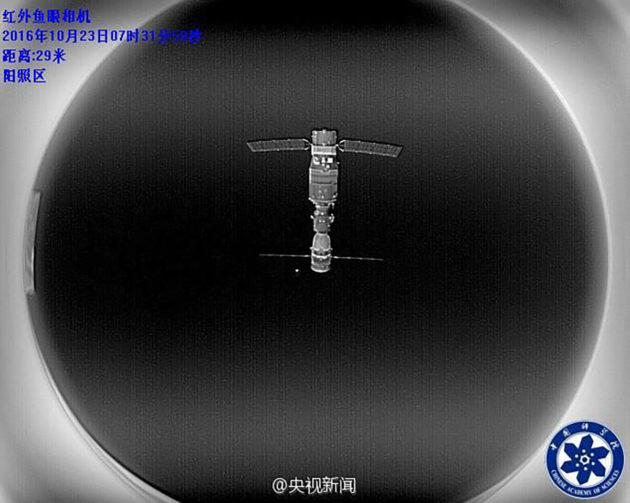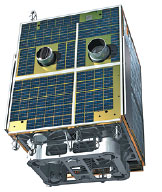On Friday, July 19th, China’s Tiangong-2 (“Heavenly Palace”) space laboratory successfully entered Earth’s atmosphere under controlled conditions and burned up above the South Pacific Ocean. This marked the successful completion of all of Tiangong-2’s tasks, which constituted China’s second attempt at testing their capability to conduct research and human operations in Low Earth Orbit (LEO).
Continue reading “China’s Tiangong 2 was Destroyed Last Week, Burning up in the Atmosphere Over the South Pacific Ocean”New ‘Selfie’ MicroSatellite Captures Images of Chinese Space Station

Here’s a great new view of China’s Tiangong II space station, taken by a new ‘selfie’ satellite. The Banxing-2 satellite is about the size of a desktop printer and was released from the station on Sunday. It has been nicknamed the “Selfie Stick” by Chinese officials and is taking pictures of the station and the docked Shenzhou XI spacecraft. The Chinese astronauts who boarded the station last week aren’t just joining the selfie craze; the 25 megapixel camera with wide-angle and infrared imagers has a specific job.
“The companion satellite monitors the conditions of Tiangong II and Shenzhou XI all the time, which is helpful in detecting failures,” said Chen Hongyu, chief engineer of the satellite program and a researcher with the Chinese Academy of Sciences’ Micro-satellite Innovation Institute.

The microsatellite as three solar panels, so can generate enough power to adjust its orbit to shoot pictures of the lab and spacecraft. Its predecessor, Banxing-1, accomplished the same mission for Shenzhou VII in 2008. The Chinese Academy of Sciences says the new model is smaller and has a higher capacity.
Now well into their 30-day mission, astronauts Jing Haipeng and Chen Dong boarded China’s second version of its “Heavenly Palace” last week. They launched Monday, October 17 from the Jiuquan Satellite Launch Center in the Gobi Desert on a Long March 2F rocket and Shenzhou-11 completed a fully automated approach and docking to Tiangong-2 on Tuesday.
During their mission, the two crew members will perform experiments from 14 different areas including biology, space life science and technological demonstrations. They have set up plant cultivation and growing experiments and have six silkworms on board for a student-based study to see how silkworms produce silk in microgravity. The crew is also doing medical testing on themselves using Tiangong II’s on board ultrasound equipment to scan their cardiovascular and pulmonary systems. They’ll also be checking for bone and muscle degradation and track any changes to their eyesight. NASA and ESA has discovered that the majority of astronauts doing long-duration space flights on the International Space Station have suffered various kinds of vision problems while in space, or upon their return.
This 30-day medium duration mission is China’s longest space mission to date, and the main task of the Tiangong crew is to help prepare for longer future missions on a larger, modular space station that, according to reports, China hopes to launch by 2018.
Further reading: Chinese Academy of Sciences, Spaceflight 101.
Weekly Space Hangout – Sept 16, 2016: Universe Sandbox
Host: Fraser Cain (@fcain)
Special Guests:
This week’s guests will be the Universe Sandbox Developers Dan Dixon (Project Lead & Creator) and Jenn Seiler (Astrophysicist & Developer).
Guests:
Morgan Rehnberg (MorganRehnberg.com / @MorganRehnberg)
Dave Dickinson (www.astroguyz.com / @astroguyz)
Kimberly Cartier ( KimberlyCartier.org / @AstroKimCartier )
Paul M. Sutter (pmsutter.com / @PaulMattSutter)
Nicole Gugliucci (cosmoquest.org / @noisyastronomer)
Yoav Landsman (@MasaCritit)
Their stories this week:
What’s the deal with Proxima b?
Unexpected gas reservoirs around large stars
Two stars, three planets in an unusual system
Overview of OSIRIS-REx after launch
Status of the Israeli Space Program following the SpaceX Static Fire Test “anomaly”
Is Pluto the source of Charon’s red poles?
China launches its second space station
We’ve had an abundance of news stories for the past few months, and not enough time to get to them all. So we are now using a tool called Trello to submit and vote on stories we would like to see covered each week, and then Fraser will be selecting the stories from there. Here is the link to the Trello WSH page (http://bit.ly/WSHVote), which you can see without logging in. If you’d like to vote, just create a login and help us decide what to cover!
We record the Weekly Space Hangout every Friday at 12:00 pm Pacific / 3:00 pm Eastern. You can watch us live on Universe Today, or the Universe Today YouTube page.


